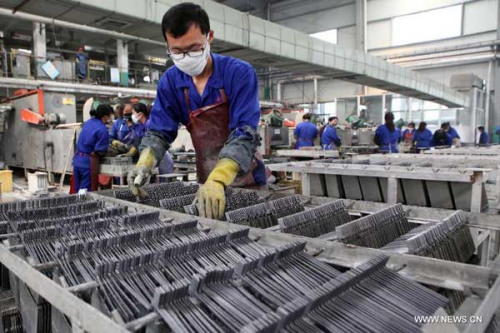
Workers produce battery lead plate at a company in Ganyu County, east China's Jiangsu Province, Oct. 31, 2012. (Xinhua/Si Wei)
China's economy now stands at a crucial point. Given the recent signs of recovery, analysts see it may continue to pick up moderately but torrid growth is over. The future growth will be kept in a moderate range with scientific, stable and sustainable development becoming its dominating feature, they add.
Innovation key in growth model shift
During the past 30 years, thanks to reform and opening up, China has become the world's second-largest economy, largest exporter as well as biggest manufacturing state. The three-decade-old growth model fueled by cheap labor, exports and heavy investment has started to fray amid pressure for higher wages and declining demand overseas due to the global slowdown. China is trying to rebalance the economy by promoting consumer spending, service industries and technological innovation.
In his report to the 18th National Congress of the Communist Party of China (CPC), Hu Jintao, its former general secretary, said China must speed up the creation of a new growth model and ensure that development is based on improved quality and performance.
Hu stressed that top priority must be given to scientific and technological innovation in overall national development; strategic adjustment of the economic structure should be carried out as the major goal of accelerating the change of the growth model.
At present, China's economic transition has entered a "deep-water" area. Experts say that to transform the economic growth pattern, innovation should be developed into a new driving force, thus realizing the internal growth of economy. China's economy has to look for more knowledge-based production. It has to look for more value addition in its production. In this way, it can keep its economy continue to be competitive.
Economist Gu Shengzu, vice-chairman of the Central Committee of the China National Democratic Construction Association, said that in the new development period, China's economy should strive to transform from "factor-driven" and "investment-driven" to "innovation-driven" featuring improved productivity by means of technological advancement; should shift from "population dividends" and "land dividends" to "innovation dividends" and "system dividends" released by deepening reform.
Donald Lewis, a research fellow at Stanford Law School, said in a recent written interview with Xinhua that the leadership of the Communist Party of China has adopted a new, future-oriented economic development model. Such a model may be termed the "Green Innovation Development Model" in which green economy and sustainable development feature prominently, he said.
"What is most distinctive, one might say brilliant, about this new Chinese development model is the pairing of sustainable development with innovation and technological advancement," Lewis said.
Sergey Luzyanin, deputy director of the Far East Institute of the Russian Academy of Sciences, said China is currently committed to pushing forward a new economic development strategy in a bid to establish a growth model on the basis of innovation and domestic demand.
He said he expected China to make an in-depth adjustment in its economic structure in the next 10 years to ensure a long, stable economic development.
Analysts agreed that when China loses the competitiveness of low labor cost, China should depend on technological innovation, human capital accumulation and IPR protection to ease the pressure of rising costs. China should steadily shift away from cheap assembly lines to high value-added production, from "made in China" to "innovate in China."
Ha Jiming, vice chairman and chief investment strategist of Goldman Sach's investment management division for China, held that from the long-term point of view, reform and opening up is the biggest dividend China has. "To achieve that, China should enhance productivity, reform income distribution system, facilitate growth in low-income regions and develop service industry," Ha emphasized.
Angel Gurria, Secretary-General of the OECD, suggested that China accommodates a process "where there is a structural transformation of the productive model." The model is "increasingly moving towards knowledge and less towards labor and accommodating millions of those who will have much higher and better skills and will be producing more high value-added products than simply producing labor," Gurria added.
Lian Ping, Shanghai-based chief economist for the Bank of Communications, said it was "truly important" to transform the growth model.
"We want to see economic growth more steady instead of more rapid, so as to alleviate pressure on the environment and resources."

Copyright ©1999-2011 Chinanews.com. All rights reserved.
Reproduction in whole or in part without permission is prohibited.